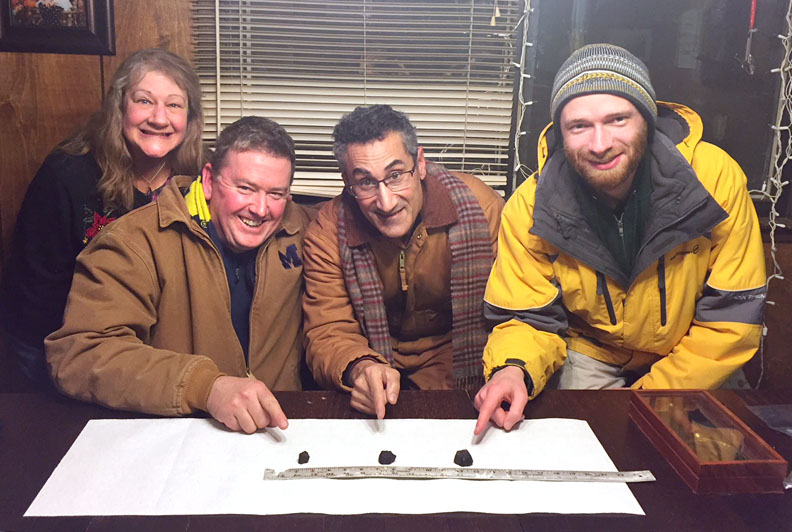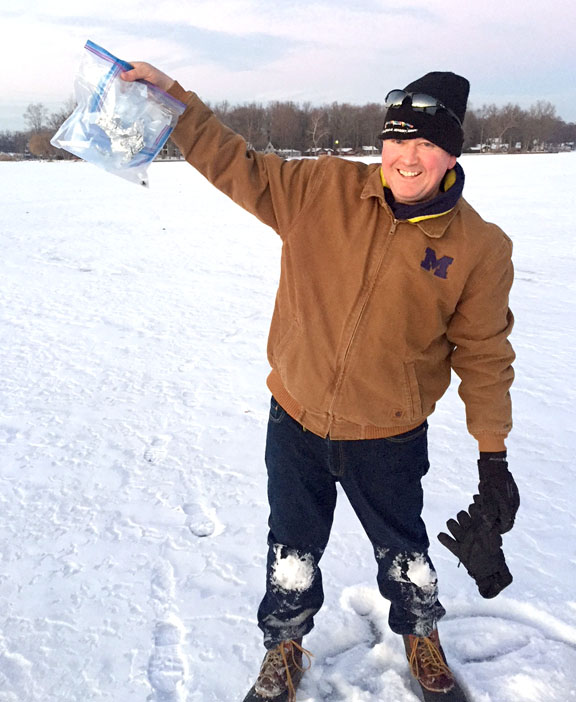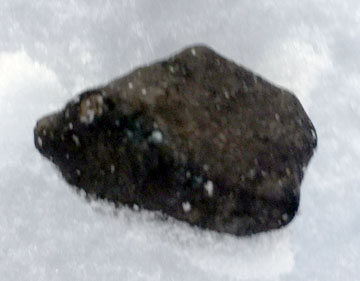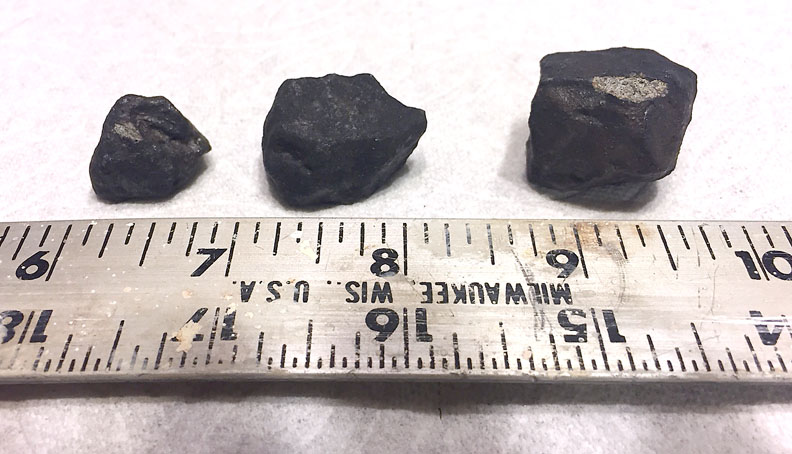
Courtesy Todd Slisher
They look like leftover gravel from a freshly laid asphalt road, but the black stones that spattered across the snow in the wake of the January 16th Michigan fireball were anything but terrestrial. They belonged to a tiny asteroid on a recent foray to the outer asteroid belt but now grounded for good on Earth.
Meteorite hunters swarmed to the strewn field near the Township of Hamburg in southeastern Michigan with heads down, walking frozen lakes, parks, and streets in the fall’s strewn field hoping to find a piece of interplanetary treasure. A few have had success, others have returned home with sore legs but grateful to join in the hunt.
Using a little ingenuity and basic geometry, Todd Slisher, executive director of the Sloan Museum and Longway Planetarium in Flint, Michigan, became one of the lucky ones. Slisher’s home security camera captured the shadow of the peak of his roof moving across the deck below like a shadow cast by a sundial gnomon. It also recorded the sound blast from the bolide’s breakup in the atmosphere, when the meteoroid shattered and began dropping what would soon become meteorites.
By measuring the angles of the roof shadow and the 104-second delay between the appearance of the fireball and its explosive crack-up, Slisher arrived at the distance (21 miles) and direction of the strewnfield from his home.
“It was just simple geometry,” he said.
He confirmed his back-of-the-napkin results with NASA Doppler weather data, which picked up the characteristic signature of falling meteoroid fragments. With a reasonably good idea of where to hunt, Slisher next organized a search team, contacting members of the Farmington Community Stargazers.
Two days after the fall, the party of five fanned out in a line 10 feet apart and walked a lake looking for out-of-place black stones. There were a few false alarms, including “frozen feces” sightings, but before long Slisher happened on a dark stone poking up from the thin snow cover.
“Oh my god, I think this is it,” he said.

Courtesy Todd Slisher
Based on color, shape and classic indentations called regmaglypts in the stone’s surface, it appeared to be the real McCoy.
“I tapped it out of the snow with my gloves,” said Slisher. “We oohed and aahed over it then high-fived and fist-bumped before I wrapped it up in foil and put it in a plastic bag.”

Courtesy Todd Slisher
It was the first meteorite Slisher ever found. Electrified by the find, the team continued their sweeps and found two more pieces that day, the largest measuring about 3.2 cm across. To preserve the newly arrived visitors from the damaging salt and oils of human touch, each was carefully wrapped in foil and bagged.
Interestingly, the five specimens were found in a line three-quarters of a mile long tracing the axis of the strewn field. The third and final find of the day was the clincher:
“The fusion crust was stuck to the ice which showed the rock’s gray interior,” said Slisher. “We knew then we had meteorites!”
Stony meteorites are primarily composed of silicate materials, which when fresh, look almost identical in color to concrete. This is particularly true with highly metamorphosed chondrites which this fall is believed to be.
One additional, solitary flake of fusion crust was also gathered. Judging from the curvature Slisher suspects that the mother rock may be a nice-sized piece just waiting to be found . . . reason to return to the site for another look.

Todd Slisher
According to NASA, this fireball was notable for its steep angle of entry, 21° from vertical. It also moved slowly because it approached Earth from the backside and then broke apart at an altitude of 15 miles, landing in the fields and lakes between the Township of Hamburg and Lakeland. Preliminary orbital elements suggest that the parent meteoroid followed an eccentric orbit that looped nearly out to Jupiter.
One of the meteorites is currently on display at the Longway Planetarium in Flint, another sits in a dark freezer. Keen on preserving any volatiles and organics the meteorite may contain, Slisher plans to send it to NASA. Proof that even extraterrestrial visitors aren't immune to red tape, he won't be able to do so until after the government shutdown ends.
 9
9









Comments
Anthony Barreiro
January 22, 2018 at 3:01 pm
Bravo!
You must be logged in to post a comment.
Alexander Vasenin
January 22, 2018 at 7:21 pm
Hi Bob! I wasn't be able to get to the article content until I logged in - it always redirected me to the login page. I don't think it's intended.
You must be logged in to post a comment.
Bob KingPost Author
January 22, 2018 at 9:07 pm
Alexander,
Here is the direct link. I hope it works for you.
http://skyandtelescope.org/astronomy-blogs/michigan-meteorite-tally-multiplies/
You must be logged in to post a comment.
Janine Myszka
January 23, 2018 at 9:28 am
This should be fixed now, thanks for the heads up!
You must be logged in to post a comment.
Martian-Bachelor
January 23, 2018 at 4:54 pm
Wow!
We had a bright fireball with a sonic boom but no obvious terminal explosion ~20 years ago, on the north end of Colorado Springs. It crossed I-25 near Palmer HS around midnight on a Friday night during nice weather. Lots of people saw it. Somebody with one of the first security cams, pointed at his cars in his driveway, got a great reflection off of a windshield.
Me and the local meteor expert/enthusiast sifted through dozens of people on the phone to meet the 15-20 or so best prospects at the location where they were, over a radius of nearly 100 miles in all directions, with surveying instrumentation, so they could draw a line on the sky with their fingertips for us to measure. There were no nicely framed sightings. When it was all compiled the data was pretty useless in even pinning down a several square mile search area.
"After a day of hunting"... It's very rare that it's *this* easy!
Very amazing.
You must be logged in to post a comment.
Graham-Wolf
January 23, 2018 at 9:21 pm
Great work folks... well done!
Bob... you've put together yet another great article.
Hoping the weather gods behave for the Total Lunar Eclipse, later this month.
First Quarter Moon already setting well after midnight, last night.
Frontal cloud-front socked me out ~ 3:30am NZDT this morning.
Some lunar pollution spoiling my views of C/2016 R2 (Panstarrs), down near M45.
Means.... "Murphy" is about!
Graham W. Wolf at 46 South, Dunedin, NZ.
You must be logged in to post a comment.
Bob KingPost Author
January 24, 2018 at 11:39 pm
Thanks, Graham. And now the Moon's getting bright, so all of us will have to wait to see R2 again.
You must be logged in to post a comment.
Russell Sampson
January 24, 2018 at 10:58 am
Bob. Excellent reporting. Two things. Is that NASA or NWS Doppler Radar (National Weather Service)? And would it be possible to put that radar imagery online? I would love to see it and it would be helpful for us educators and astronomy outreach people.
You must be logged in to post a comment.
Bob KingPost Author
January 24, 2018 at 11:37 pm
Hi rsampson,
The trace was made using an online tool from Incorporated Research Institutions for Seismology (IRIS) at http://www.iris.edu/hq/
You'll find the tool here: http://service.iris.edu/irisws/timeseries/docs/1/builder/
My source tells me that there's a significant learning curve in learning to identify sonic boom fireball signatures, so be prepared to spend some time learning
to dig up the data. I wish you well and hope this will be useful.
You must be logged in to post a comment.
You must be logged in to post a comment.